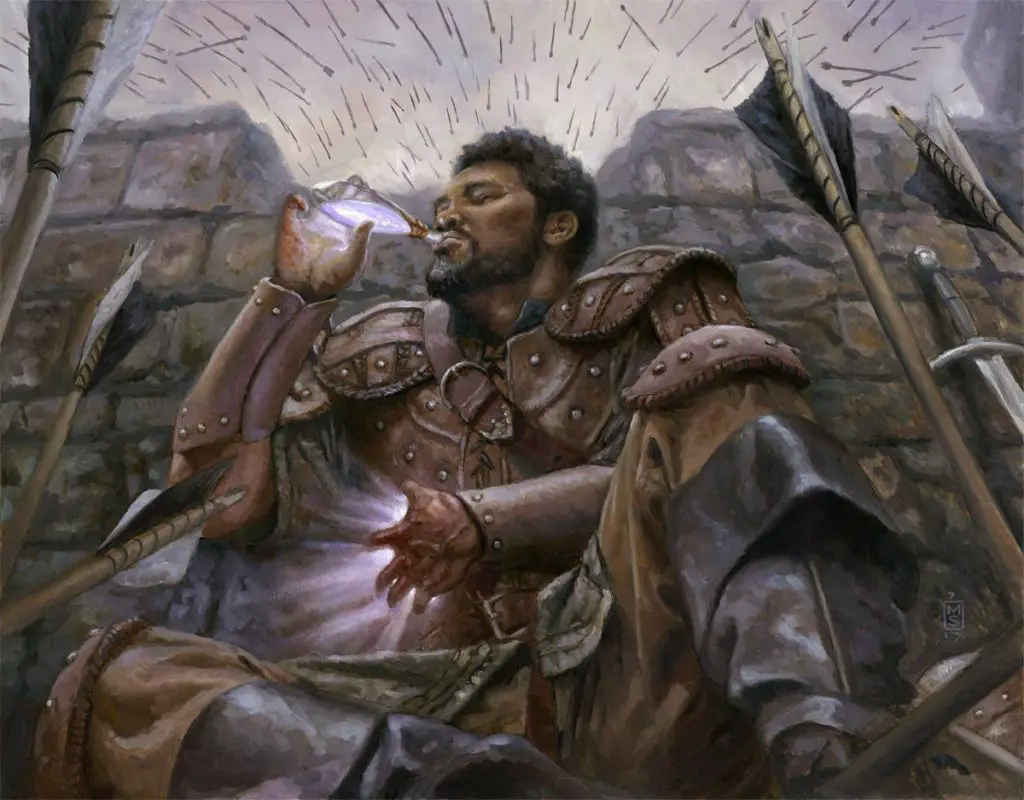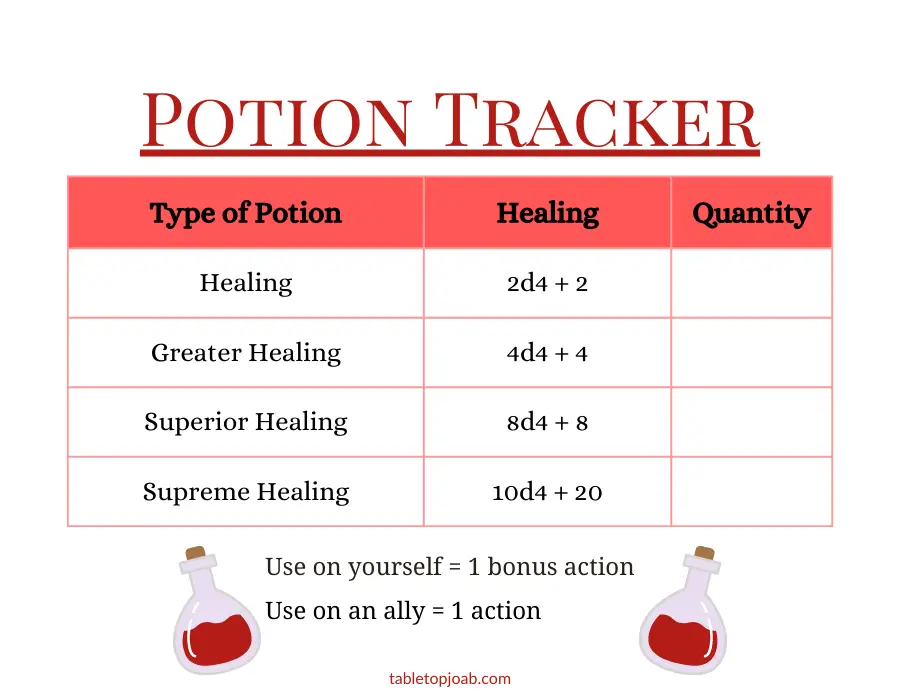Going on adventures, delving into ancient dungeons, and fighting vicious monsters is tough work. There are bound to be times when your party’s healer runs out of spell slots or isn’t able to get to you before things get too bad!
It’s in those times that you’ll be glad you picked up some healing potions for your journey!
These lovely red vials of sweet healing power have saved the lives of many adventurers. It’s always wise to have at least a couple on you!
In this article, we’re going to look at healing potions in D&D 5e. We’ll cover how they work, how much they cost, and how you can make your own!
I’ve also got a handy tracker in this article that you can use in your own games!
Acquiring Healing Potions in D&D 5e
While you might get lucky and find some healing potions in a treasure chest or on an enemy you’ve defeated, there are other ways of acquiring healing potions.
Generally, you’ll either be buying them or making them yourself if you’re playing a more alchemically inclined character.
Let’s go over what you can expect with both options!
Buying Healing Potions
The most common way of acquiring healing potions is to buy them from your friendly neighborhood merchants.
Some general supply stores or even taverns might carry them, but your best bet is to find a specialist. That might be a merchant specializing in magic items and curiosities, or a potion-maker or alchemist in the town.
Of course, it might also be worth seeing if there happens to be a nearby group of Druids. After all, crafting magical goods from natural ingredients is something they’re especially good at!
While Druids tend to be hermits, they might still be willing to use their natural wisdom to craft you some potions in exchange for something.
(Just note that while some Druids are happy to trade for money, others might instead give you the potions in exchange for help with some problem they’re having.)
The costs for healing potions can be a little confusing since the information is spread over a few books. In fact, the Player’s Handbook curiously only mentions the standard Potion of Healing!
While the Dungeon Master’s Guide gives a range of prices based on rarity, I prefer something a little more concrete.
| Potion Type | Rarity | Cost |
| Healing | Common | 50 gp |
| Greater Healing | Uncommon | 200 gp |
| Superior Healing | Rare | 2,000 gp |
| Supreme Healing | Very Rare | 20,000 gp |
Depending on the merchant selling the potions, the prices may vary. However, these prices are more in line with the “fair market value” of healing potions in 5e.

Making Healing Potions
Spending the time to make your own potions can be a great way to save your hard-earned gold. If you’ve got more time than coin, it’s worth knowing how to do it!
After all, making your own healing potions costs half as much as buying them!
To make healing potions, a character must have proficiency with an herbalism kit. Additionally, they must have gold (to represent the cost of materials) and time (to brew the potions.)
You can see the time and gold costs for crafting each potion on the table below.
| Potion Type | Time to Craft | Cost |
| Healing | 1 day | 25 gp |
| Greater Healing | 1 workweek | 100 gp |
| Superior Healing | 3 workweeks | 1,000 gp |
| Supreme Healing | 4 workweeks | 10,000 gp |
If you’re going by the Rules as Written (RAW), it’s as simple as telling the DM that you would like to spend your downtime brewing a potion and paying the cost. You then spend the necessary time crafting the potion.
A Fun Worldbuilding Opportunity
So while there aren’t specific healing potion ingredients in 5e, that does open up a fun worldbuilding opportunity.
Based on local herbs and/or the presence of something like a magical spring (or something similar), the ingredients required to make your own healing potions (and the strength of what you can make) might vary.
Maybe the adventure starts in a sleepy mountain town. A member of the party is proficient with herbalism kits and is familiar with the properties of the various plants that grow in the area.
When in an area where those herbs can be found, they’re able to make standard healing potions (with the time and materials, of course.)
But as the adventure goes on, the party goes to far and distant lands with new plant life.
Who’s to say that there aren’t people in these new locations that are familiar with making various types of potions based on the various plants that grow in their environment?
Befriending these people (and maybe a couple of nature checks) would let the party’s potion-brewer learn these new recipes.
Some recipes might use different ingredients to create the same effect as a standard potion of healing. However, others might be able to produce stronger healing potions.
As you’re worldbuilding, this adds more depth to the various places along the adventure. Furthermore, it gives the party a better opportunity and reason to learn more about the people and culture there.
Sure, a type of weed that can be used for a very potent healing potion grows in a nearby grotto. But the locals know that attempting to harvest these weeds without asking permission from the spirit that lives there is a quick way to invite its wrath!
Related: Core Assumptions When Worldbuilding
How Rare Are Healing Potions?
Generally speaking, healing potions in D&D 5e are considered to be common items.
As shown on the table in the section on buying potions, more potent potions increase in rarity depending on how strong they are.
But things might be different in your campaign’s setting.
Some campaigns take place in “high magic” worlds where wondrous and magical items are much more common.
In a setting like that, the typical vendor might carry standard and greater potions of healing with certain high-end specialists selling stronger options.
But that wouldn’t be the case in a “low magic” setting where magic items are considerably harder to come by.
In a low magic setting, healing potions will be much harder to find and can possibly cost much more to purchase. Even if you’re trying to make your own, the supplies you need might be specialized and expensive.
Personally, I enjoy it when healing potions are harder to come by. It adds extra pressure and drama to the decision of whether or not to use them!

Using Healing Potions
Healing potions consist of one ounce (30 mL) of liquid. To gain the benefit, you must drink the whole thing unless specified otherwise.
You gain the healing effect of the potion immediately. (We’ll go over how much each type of potion heals in just a moment.)
With the Rules As Written (RAW), using a healing potion (for either yourself or an ally) takes an action.
This can be very tricky as it relates to your character’s overall action economy.
You have to decide if the hit points recovered by using the healing potion are more important than attacking, casting a spell, or whatever else you would use your action for.
But I think we can do a bit better here…
Homebrew Option for Using Healing Potions
Let’s be honest, using your turn only to take a healing potion isn’t very exciting.
Plus, you’ll probably just get smacked again (removing the point of drinking the healing potion) unless you’ve got a way to use your bonus action to get away!
A spellcaster with Misty Step prepared or a Rogue using their Cunning Action feature to disengage might be okay, but it’s still far from an ideal situation…
One of the most popular homebrew rules in D&D 5e specifically addresses this issue.
Instead of requiring an action to drink a healing potion, make it only take a bonus action. If using the potion on an ally, it still requires an action.
Using this option means that characters can still do cool stuff on their turn, but there is still a cost to their action economy.
It’s simple, clean, and practical!
Related: 10 Optional Homebrew Rules for D&D 5e
How Much Do Healing Potions Heal For?
There are four levels of healing potions in D&D 5e: standard, greater, superior, and supreme.
It can be tricky to remember what each healing potion heals for, so I made a handy potion tracker that I give to my players.
We print them out and slide them into their character folio for easy tracking of how many healing potions the character has and how much they heal.
Feel free to use it for your group as well!

By the way, I strongly recommend using character folios if you play D&D in person. They’re worth their weight in gold and make keeping things organized and tidy incredibly easy.
You can check out my review of the UltraPro D&D Character Folios for more!
Conclusion – Healing Potions in D&D 5e
The hardest thing about healing potions in D&D 5e is keeping track of all the rules. It’s a little weird that the information is spread over three books, but I hope you’ve found this article helpful!
Got any questions about healing potions in D&D 5e? Let’s chat in the comments!
Want all the latest player guides, DM tips, news, reviews, and more for D&D 5e? Sign up for the Tabletop Joab newsletter below!
You can also follow me on Facebook and Twitter!
If you found this article helpful and want to support the site, you can buy me a coffee here! (It’s not expected, but very appreciated!)









